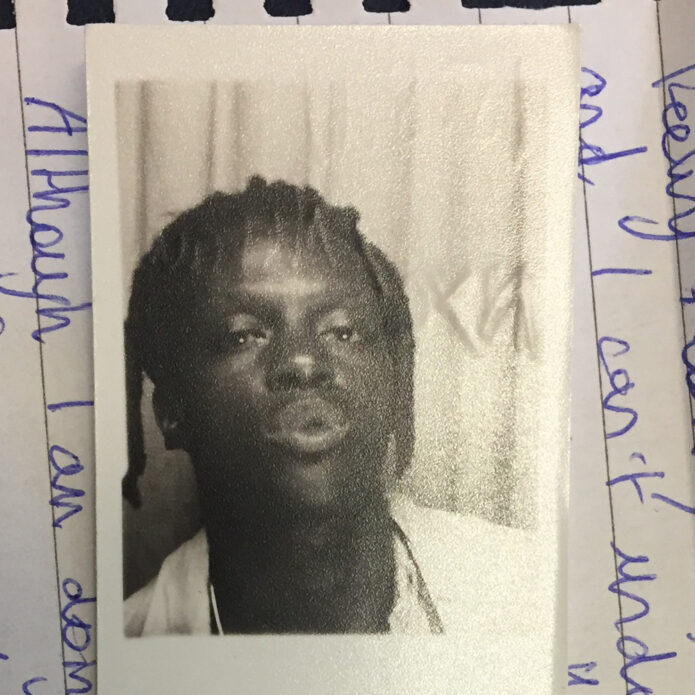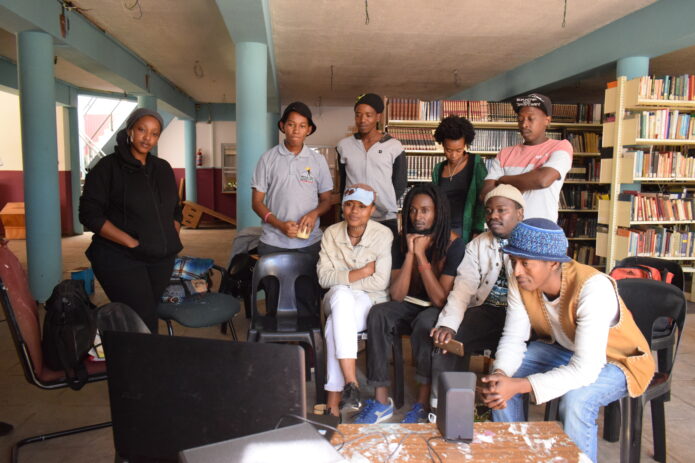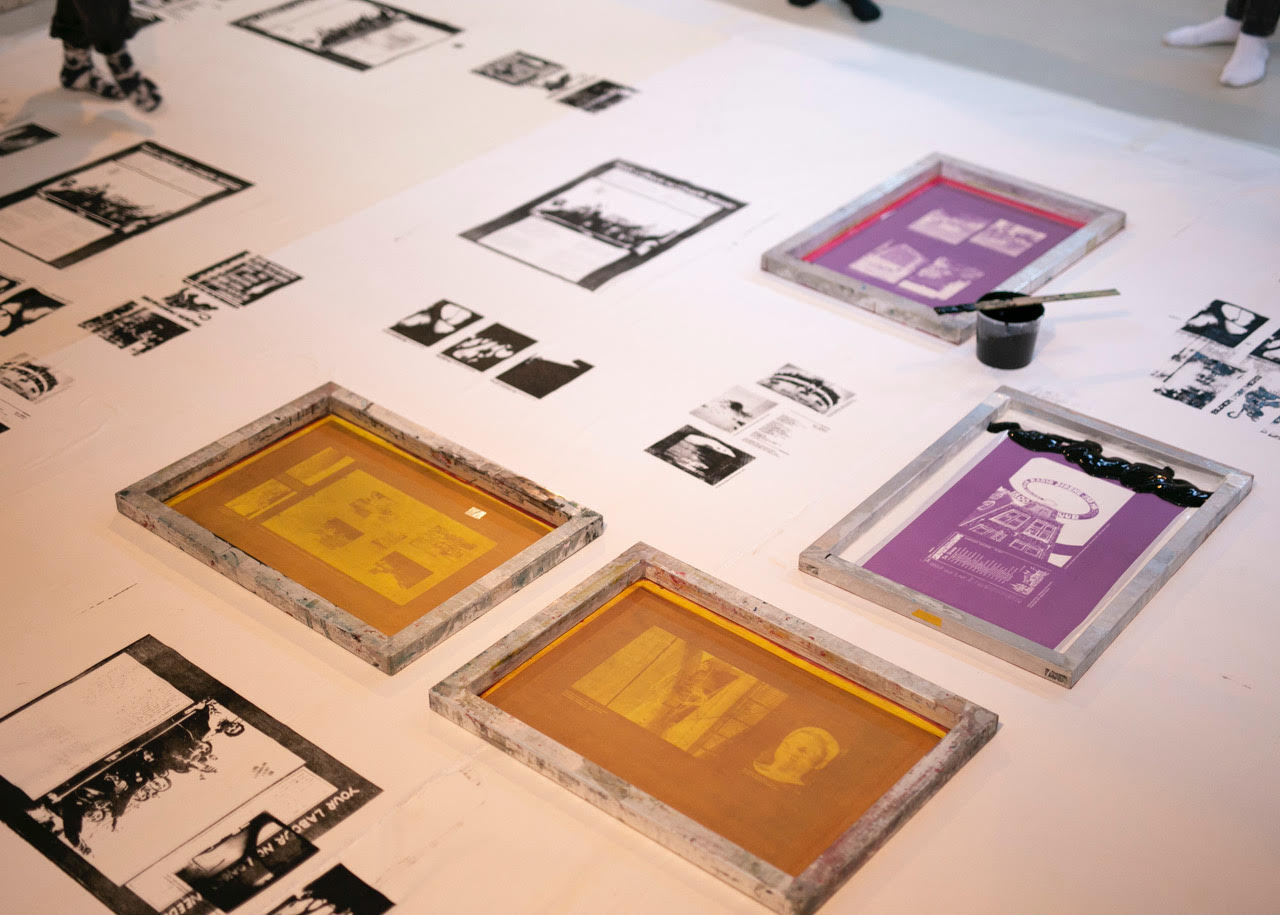 Werker Collective, screen printing with images sent by students. Photo: Zindzi Zwietering
Werker Collective, screen printing with images sent by students. Photo: Zindzi Zwietering Decolonial Futures: Second Term
Decolonial Futures is an exchange programme organised between the Sandberg Instituut, the Rietveld Academie and Framer Framed in Amsterdam as well as Funda Community College in Soweto, South Africa.
In the first term students working across the disciplines of art and design familiarised themselves with Funda’s socio-cultural context which is inseparable from the rich history of Soweto and South Africa at large. Parallel to sessions in Soweto, the participants at Framer Framed in Amsterdam – led by curator and poet Ibrahim Cissé – examined their understanding of historical and hegemonic systems of knowledge production. The students began to explore digital methodologies which could be used to create dialogue and engagement between former colonised nations and former colonising nations. Read more details about each session in the first term here. Below a summary of the sessions in the second term.
Text: Evie Evans
Introduction Session
9th March 2021
In this second term, Decolonial Futures will collaborate with sonsbeek20→24 under their curatorial framework which focuses on labour and the sonic. Over the course of 2 months students will look into traditional forms of African storytelling and the creation and transfer of knowledge via music and songs in various different cultures. Organisers Simangaliso Sibiya, Phumzile Nombuso Twala and Dorine van Meel welcomed the participants and introduced this new iteration of the program.
In the online meeting, co-curator at sonsbeek20→24, Aude Mgba introduced the theme of histories of labour and their relationship to coloniality. Sound may not be a first idea when thinking about the decolonial which is precisely why it’s so important for us to consider. Aude noted that sound disturbs linearity; it provides an alternative way of looking at history which is often overlooked. Aural and oral histories alter the way we communicate knowledge, how we process it and translate it into different structures. The participants of Decolonial Futures will look towards lyricising uncomfortable topics of colonialism rather than theorising about them.
Read more about the curatorial framework of sonsbeek20→24 here.
Amal Alhaag, another co-curator at sonsbeek and the curator of the Framer Framed exhibition Diasporic Self: Black Togetherness as Lingua Franca, created a mixtape which encompasses this interconnectivity between gender, race and capitalism.
“Words that don’t rhyme with productivity nor reverberate labour. Who is afforded to be lazy? To drop-out or burn-out? If anything, this mixtape is not a call to action, it’s an invitation to listen caringly in the lower registers. To listen between the breaks. Pause to the water drops. Water drops break the beat into an intimacy that is both fleeting and familiar, moving between the belly and the ears.”
Listen to the mixtape online here.
For the first session musician and composer Sami El-Enany and sound artist Shenece Oretha, who will lead the Amsterdam classes, introduced themselves and their practice.
London based multi-disciplinary artist Shenece Oretha discussed the “mobilising potential of sound”, as a tool and methodology sounds can create new understanding. What does it mean to sound something out, to say it out loud? What does it mean to resonate with someone or something, to tell someone “I hear you”? Shenece’s work sounds out our own spaces and asks us to questions our own sonic acts.
She shared snippets of her other work but explained the live performance Here, Present which is a form of remembrance, speaking out the names of black people killed in acts of violence and political struggle. Shenece makes these names audible, signalling their presence within their absence in a kind of choreography of sound. Listen to Here, Present online here.
Sami El-Enany is a composer and producer who will also lead the second term sessions for Decolonial Futures. His practice lies in creating sounds and scores as well as recognising sound as a form of ‘signalling’. Sami explained that sound can be a form of control, or sounds can be utilised as tools – often for manipulation in orientalist or colonial representations by the West. In 2020 however, Sami ironically focused on the power of sound and music to bring people together such his progressive radio projects. The participants also listened to a song from his new electronic dance album created in 2020 during the COVID-19 pandemic.
Towards the end of the second term, the final classes will be led by Werker Collective. Inspired by Der Vereinigung Der Arbeiter-fotografen (The Association of Worker Photographers), the collective looks towards alternative representations of labour that involve intersections of queer, feminist and ecological perspectives. Their connection to Decolonial Futures is through an exploration of the ways in which colonisation, as a form of oppression, controls the reproduction of life – both human and non-human. They call the students of Decolonial Futures to address questions of labour and invisibility and create a sound archive that will culminate into a radio show within sonsbeek‘s public programme.
The corresponding classes at Funda Community College in Soweto will be led by media practitioner and radio pioneer Sibusiso “General” Nxumalo who will invite participants in both places to explore traditional forms of African storytelling and the creation and transfer of knowledge via music and songs in various different cultures.
Participants also had a moment on Tuesday to listen to a song by Hugh Masekela a legendary South African jazz musician, representing a culmination of the themes discussed in the first session, and to be discussed throughout the second term. Masekela’s music has a deep relationship with Soweto and South African history, and has made its journey to the students in Amsterdam.
Listening to these various kinds of music and sound waves, sharing audio through Zoom, the students were sounding out their own online space, too. The act of unmuting your microphone, unmuting yourself in a broader sense to speak and be heard seems a fitting beginning to a curriculum of conversation. Decolonial Futures is, most fundamentally, a dialogue which at its definition involves an exchange of time, words, and experience. In the first term Ibrahim asked students “what are you willing to give?” Perhaps now in the second term, it begins by offering a listening ear.
Sound as a way to occupy space
16th March 2021
Musician and composer Sami El-Enany began the second session with a listening exercise. Everyone took a moment to listen to their surroundings, focusing on a single sound. Once it had been heard and recognised Sami asked the participants to ignore that initial noise and listen beyond it to other sounds within their spaces.
In some ways, therefore, Zoom offered one benefit as everyone had their own spaces and sounds to identify and share. On the other hand, it was discussed that the muting options online exacerbated a sense of distance from other participants as there was no sound attached to their movements on screen; offering no audio output or reassurance that people were really there, present and listening.
Listening to a noise (and is that different to a sound?) without knowing its immediate source forces the imagination. Without an assumed image in your head of where a sound originates from, or where it’s going, best highlights sound as affect. Without being acknowledged or interpreted yet – before your brain can communicate to you what a sound is, we are already reacting to it and being affected by it.
Considering affect in an alternative way, however, Sami asked a question central to today’s session: How can radio be used to affect change? He briefly delved into the recent history of radio and internet radio which meant, previously, what you heard was where you were. The invention of the radio allowed ‘acousmatic’ sounds to be possible; a sound whose source is not immediately here and now.
Sami then shared a series of resources to encourage the participants to think more about the power and possibilities of radio. Students listened to Halim El-Dabh’s “Wire Recorder Piece” from 1944, some of the first recorded electronic ambient music
He shared the story of Mbanna Kantako an African American radio pirate and freedom fighter who created his own radio station for his public housing community in Springfield, Illinois. His Black Liberation Radio, later named Human Rights Radio, was a pivotal form of resistance against police brutality and racism in the USA at the turn of the century. Kantako use of radio as a form of resistance raises questions about who has the power to speak, who has the power to listen, and what does it mean to hear music and stories from other communities.
On the subject of more recent forms of black resistance. The website You are Listening to Detroit enables visitors to listen to local US police radio on top of randomly generated ambient music and was importantly during the Black Lives Matter protests in 2020. It is a poignant listen, broadcasting what should be public knowledge but instead signifies fear and violence for many citizens. The website also operates to connect people from all over the world to local policing, highlighting that these forms of oppression are in fact global.
The invention of the radio, and its dissemination of the internet exemplifies its power as a tool to occupy space as well inviting others into that space. Sound itself – as compared to visual arts for example – has an oppressive quality, too. In a given space, you are forced to listen and experience audio. Your ears cannot be closed in the same way as your eyes. Additionally, although the participants were physically and aurally distanced on Zoom, through its acousmatic quality has the ability to connect so many places, transporting people through sound. A tangible example of this is through the map Radio Garden where you can zoom in on live radio stations all across the globe.
Radio as a tool to give voice to those who should be heard, and to be heard across time and space sparks wonderful possibilities for how sound can be used as part of decolonial methodology and the dissemination of knowledge.
Depth, volume, space and time
23rd March 2021
The second session with Sami El-Enany began with participants sharing their discoveries from Radio Garden throughout the week. From a Tamil community radio station in Switzerland to an artic post broadcast, students came across a wide range of radio most notably music and cultural stations.
Locating these transmissions and discussing them together prompter a more critical analysis of what they had heard; who is speaking and who is listening? It is important to reflect on your own position to recognise if you are the intended audience for a certain sound and why. These questions could also be interpreted as’: who is occupying space?’ of the radio waves.
Another valuable find was the website Radiooooo which acts as an online archive for radio stations across the globe and through the years. A visitor can travel through time, space and radio.
To emphasise the way sound or sound art can represent a similar passing of time or transportation, Sami shared a clip of his work #NauruFilesReading. The political performance was created by Sami and a group of activists to bring attention to the suffering of refugees on the island of Nauru, by the Australian Government. The performance involved the reading of the Nauru Files, a database of over 2000 incident reports leaked to the Guardian Australia, outside Australia House in London on 26th August 2016. The reading, as a public intervention, took a total of 10 hours to voice incidents of violence and abuse of the detained refugees.
The work blurs the boundaries between sound work and political action, or rather erases the country completely. Sami’s summary video is an archive of work, edited in a way to highlight the passing of time and repetition of the reports. The layered voices creating depth, volume and space. Sound, whilst creating an affect already, can be used to represent something else – a feeling, a moment in time as well as being a political act in itself. Now it is up to the students to decide how to translate these capabilities into the sound archive for the sonsbeek20→24 program.
What is a sound that moves you?
6th April 2021
For the first session following a break, sound artist Shenece Oretha began with a Tuning Mediation exercise inspired by composer and artist Pauline Oliveros. During a Tuning Mediation people “sound out space”, that is, making a noise or listening to others and mimicking the sound they make to create a kind of chorus.
Although such deep listening exercise are usually conducted together with others in the same room, it was a novel way to test the listening capabilities on Zoom; which sounds would the meeting platform prioritise over others? What would everyone be able to hear?
The students practiced this form of active listening by paying attention enough to produce the same sound, attuning to each other. Shenece also pointed out that being silent is still being part of the composition by allowing someone else’s sound to take up space, calling back to Sami’s emphasis on using your voice to occupy space which is an important consideration for decolonial activism. Only by actively listening to each other can we recognise the moments to speak up or be silent.
Shenece led the participants to share sounds or a sounds that moves them, whether it is moving in the broadest sense possible: emotionally, physically, spiritually, politically or otherwise. It could also be a sound that is moving you presently or in the past, in whatever form is possible to share from sound recordings, videos or even a photograph.
The goal for Shenece’s first exercise was precisely personal – they shared a clip of singing from the series Small Axe which represented a moment of a black & British experience in 1980s London – in order to explore why certain sounds move us. Nostalgia aside, what is it about a certain sound that can evoke different emotions?
This way of sharing also prompted students to hear another person’s way of listening and offer a new interpretation of sounds. Students discussed the legacy of migration and slavery through music, especially in afrobeats and reggaeton, as well as its tendency towards resistance.
For particular noises, such as seals communicating underwater or an orchestra of frogs croaking in the Chilean forest, participants speculated whether such noises can really be perceived or understood. Western tradition frames everything as perceivable, often privileging the eye over the ear leading to less understanding of the power of sounds. What sounds are we unfamiliar with, or familiar enough to intimately know it’s pauses or motions? Other students crafted “sonic collages”, an amalgamation of shorter sound clips which painted a fuller picture of a place or feeling.
Exploring sounds that move us will continue into the next session but marks a new way of producing knowledge communally through conversation.
A tapestry of sound
13th April 2021
Framer Framed was able to welcome a small group of students to back into our space to connect in person for the first time. Participants “sounded out the space” through the exercise of a Tuning Meditation as a continuation from last week.
Students incorporated the sounds that move them which they shared during the previous session. Phrases in Dutch, English, and Spanish were paired with the soothing sound of running water as well as recordings of frogs or a busy street, producing a hypnotic tapestry of sound. Harmonies and rhythms emerged naturally as students reproduced particular sounds; being in the same space meant they were more aware of each other’s presence and the origin of each noise. This recording will be sent to the participants in Soweto as a sonic collage, a kind of introductory meeting through sounds that hold meaning for the group in Amsterdam.
Shenece emphasised that everyone carries sounds with them – your voice, a melody stuck in your head, the rhythm and gait of your – sounds which they brought into the space of Framer Framed to share with others. The Tuning Meditation also highlights the group’s responsibility to create something and maintain it together – a lesson which will, hopefully, be carried into the future and beyond the framework Decolonial Futures into other projects.
Imaging the Sonic
20th April 2021
The last session of Decolonial Futures this term brought the students back to Framer Framed for a print workshop led by Werker Collective. Marc Roig Blesa and Rogier Delfos have been working on this project, at the intersection of labour, ecofeminism and the lgbtqi+ movements, since 2009. Their recent development of the weaker archive “provides the tools to enable the production of anti-capitalist, anti-imperialist and anti-patriarchal political imagination” in different contexts. For sonsbeek20→24, Werker Collective are developing methods of collective archiving, dying and printing, in relation to a sound archive of labour.
Werker Collective asked the students of Decolonial Futures to think about imagining and “Imaging the Sonic” within a decolonial framework. Participants were asked: What sounds do certain images evoke and why? They then prepared images with captions which were sent to Marc and Rogier to become the foundation of screens for printing. Werker Collective introduced their work, using images submitted by students and from their own archive which connected themes of political resistance, colonial history, and community practice.
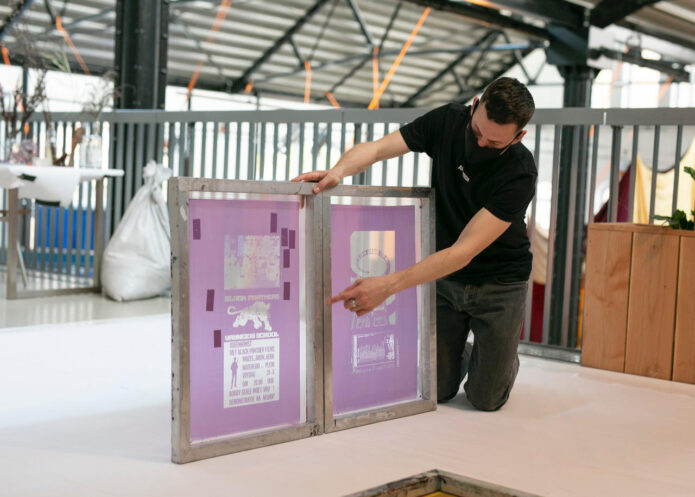
Marc Roig Blesa of Werker Collective explaining photos from the Black Panther movement in the Netherlands. Photo: Zindzi Zwietering.
With a brief guide into the process of screen printing, students worked quickly and simultaneously to print the images in black and white onto strips of fabric. The result was a striking collage of images overlapping onto sheets. One strip will be kept for sonsbeek20→24, one for the Decolonial Futures group in Amsterdam, and one is reserved for the parallel group in Soweto, South Africa – bringing together everything students have contributed for the second term of the program.
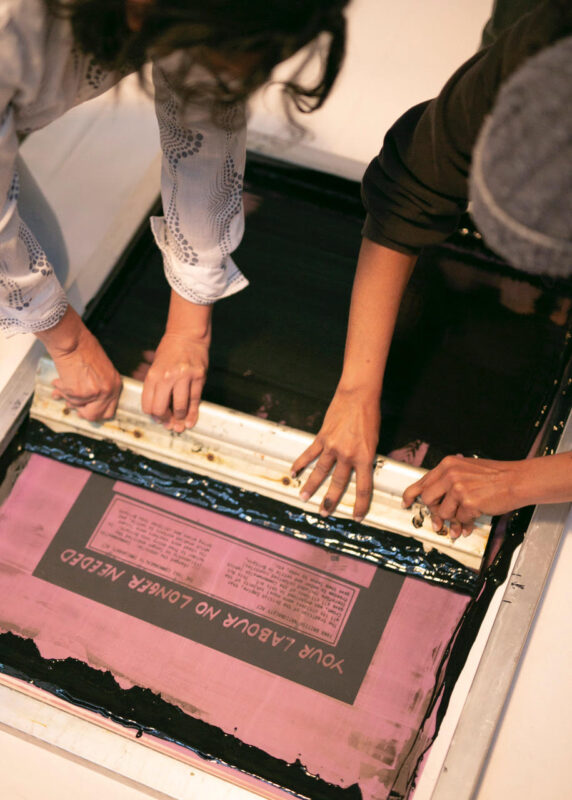
Other resources
Podcast by choreographer Hofesh Shechter, designed to be heard late at night, with headphones, in a completely dark room – with some space to move.
Inventions in Sound, produced by Eleanor McDowall, deaf poet Raymond Antrobus explores the art of translating sound for the eye, looking at the poetic possibilities of closed captions.
Diasporic self: sound as lingua franca, a public event curated by Amal Alhaag on the role of music, its ability to help shape (new lexicons) and influence the formation of the Diasporic Self in contemporary black cultures across Europe. Part of the evening was the performance ??Fullmoons later/ wata kulture II, by d’Em’kal Eyongakpa. The performance consists of a 5.1 surround sound experience, soundscapes, vj’ing, spokenword, music excerpts and percussion. Em’kal references Etokobi rhythmic variations (cross-river basin, south west Cameroon), jazz (John Coltrane, Africa/Brass, 1961/ Billie Holiday: Strange fruit), Amiri Baraka, (Why’s/Wise, 2009) among others and connect possible references to the Middle Passage with the ongoing mediterranean refugee crisis.
- sonsbeek20→24
- Werker Collective
- Funda Community College - Soweto
- Sandberg Instituut - Amsterdam
- The Gerrit Rietveld Academie
Links
Shared Heritage / Action Research / Community & Learning / Colonial history / South Africa /
Agenda
Decolonial Futures Workshop Series: The Womb Republic - How to Rebirth
A cultural exchange programme with Funda Community College, Soweto, South Africa
Decolonial Futures: Workshop with Aditi Jaganathan
First term of the Decolonial Futures programme 2021-2022 with selected Artist Talks
Decolonial Futures: Workshop with Sara Blokland
First term of Decolonial Futures programme 2021-2022
Decolonial Futures 2020-2021: Second Term
Online seminar as part of the second term of Decolonial Futures
Decolonial Futures 2020-2021: First Term
Open Call for participants for the Decolonial Futures Cultural Exchange Programme 2020-2022
Network
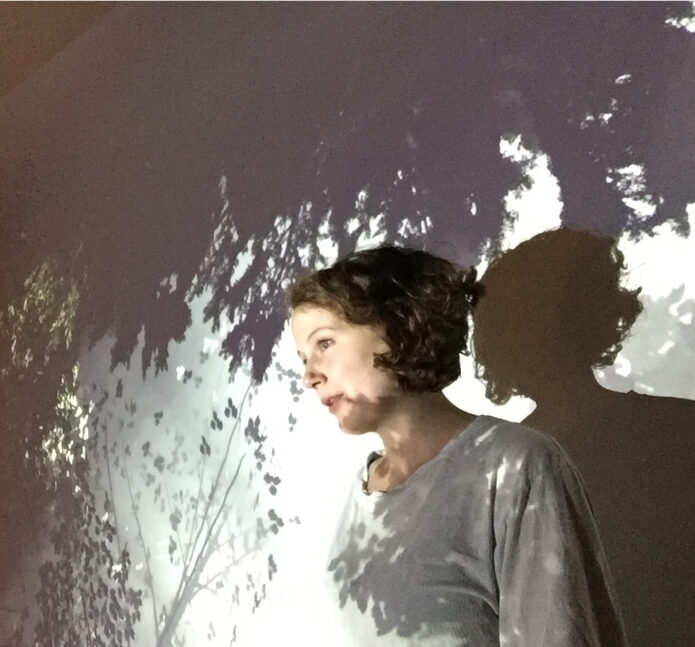
Dorine van Meel
Artist, Writer, Educator
